1. Introduction
 Corsair has been one of the biggest memory module manufacturers since 1994. Their XMS product series is designed for the unique demands of the serious enthusiast community. XMS stands for eXtreme Memory Speed. The XMS family includes XMS2, high performance DDR2 modules, XMS Xpert (the first modules with real-time display of
parametric data), XMS Pro Series (gaming memory with real-time activity LEDs) and XMS
Classic with black or platinum heat spreaders.
Corsair has been one of the biggest memory module manufacturers since 1994. Their XMS product series is designed for the unique demands of the serious enthusiast community. XMS stands for eXtreme Memory Speed. The XMS family includes XMS2, high performance DDR2 modules, XMS Xpert (the first modules with real-time display of
parametric data), XMS Pro Series (gaming memory with real-time activity LEDs) and XMS
Classic with black or platinum heat spreaders.
In this review, we will be testing the XMS TwinX 1024-3200XL RAM modules, part of the XMS Classic series with black heat spreaders. These DDR memory modules are clocked at 400MHz.
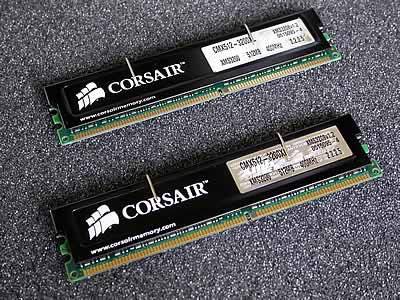
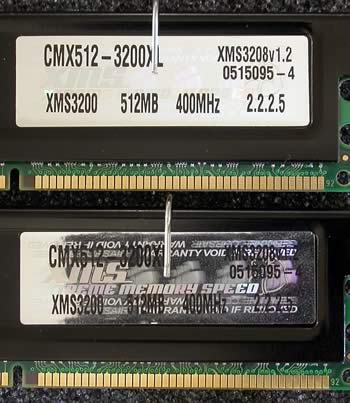

Corsair uses Samsung's K4H560838F memory chipsets for its Memory modules. The K4H560838F is 268,435,456 bits of double data rate synchronous DRAM
organized as 4x 8,388,608 / 4x 4,194,304 words by 4/16bits, fabricated with
SAMSUNG's high performance CMOS technology. Synchronous features with Data
Strobe allow extremely high performance up to 333Mb/s per pin. I/O transactions
are possible on both edges of DQS. Range of operating frequencies, programmable
burst length and programmable latencies allow the device to be useful for a
variety of high performance memory system applications. Below you can see a list of features for these chipsets.
- 200MHz Clock, 400Mbps data rate
- VDD= +2.6V ± 0.10V, VDDQ= +2.6V ± 0.10V
- Double-data-rate architecture; two data transfers per clock cycle
- Bidirectional data strobe L(U)DQS
- Bidirectional data strobe(DQS)
- Four banks operation
- Differential clock inputs(CK and /CK)
- DLL aligns DQ and DQS transition with CK transition
- MRS cycle with address key programs
- Read latency 3 (clock) for DDR 400
- Burst length (2, 4, 8)
- Burst type (sequential & interleave)
- All inputs except data & DM are sampled at the positive going edge of the system clock(CK)
- Data I/O transactions on both edges of data strobe
- Edge aligned data output, center aligned data input
- LDM, UDM for write masking only (x16)
- Auto & Self refresh
- 7.8µs refresh interval(8K/64ms refresh)
- Maximum burst refresh cycle : 8
- 66pin TSOP II Pb or Pb-Free package(RoHS compliant)
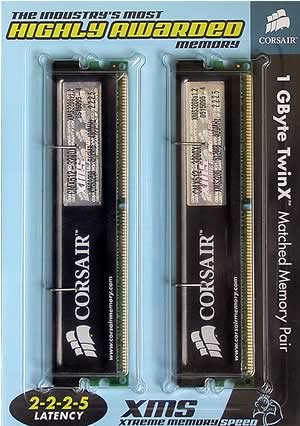
- Specifications
Below you can see the specifications table for the Corsair TwinX 1024-3200XL RAM modules.
Part Number
|
TWINX 1024-3200XL |
| Package |
1024MB kit (2x512MB) (dual rank) |
CAS Latency
|
2-2-2-5 |
| Test Voltage |
2.75 V |
| Speed |
DDR 400 MHz (PC3200) |
| Type |
184-pin DDR SDRAM |
| Error Checking |
Non-ECC |
| Registered/Unbuffered |
Unbuffered |
| Heat Spreader |
Black Finish Aluminum Heatsinks |
| Manufacturer Warranty |
Limited lifetime warranty |
| Quality Control |
Two matched modules paired immediately after testing |
2. Test Configuration & System
After installing the two memory modules, we checked the SPD Timings using the latest CPU-Z.
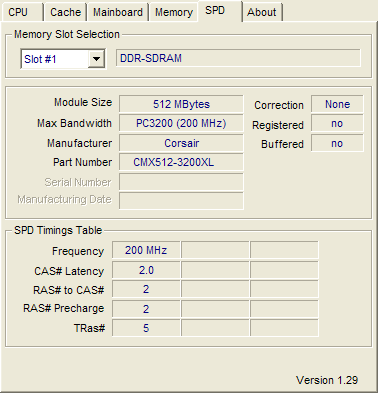
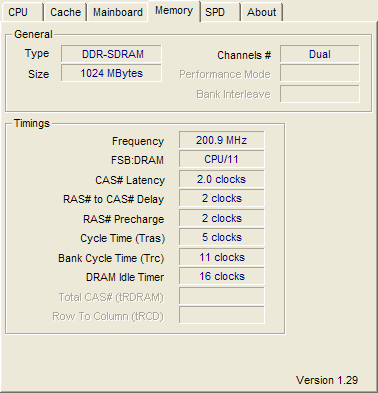
For these tests, we used an AMD Athlon 64 3500+ CPU (Newcastle), running at 2200MHz.


We will also be comparing the Corsair XMS TwinX 1024-3200XL RAM modules with the OCZ EL DDR PC-3200 Platinum Revision 2. Below you can see the SPD Timing for the OCZ Platinum memory modules, again according to CPU-Z.
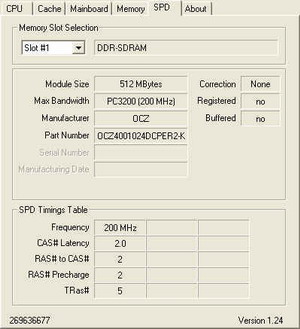
Here's a rundown of our testbed:
System Specifications
CPU: AMD Athlon 64 3500+ CPU (Newcastle)
Case: Antec
Motherboard: Abit AN8 Fatal1ty
Power supply: CoolerMaster 450W
Memory: Corsair XMS TwinX 1024-3200XL (2x512MB)
VGA: ASUS 6800GT PCI-E
Hard Disk Drive: WD800JD 80GB 7200RPM
OS: Windows XP Pro SP2
Drivers: 7.1.8.4
DirectX: v9.0c


Benchmarks & Applications used
- Memtest86+-1.60
- Sisoft Sandra 2005
- PcMark05
- Performance Test V5.0 ( PassMark)
- Half Life 2 - VST
- CPU-Z v1.29
3. SiSoft Sandra 2005
 SiSoftware Sandra is a 32 and 64-bit Windows system analyser that includes benchmarking, testing and listing modules. It tries to go beyond other utilities to show you more of what is really going on under the hood so you draw comparisons at both a high and low-level in a single product.
SiSoftware Sandra is a 32 and 64-bit Windows system analyser that includes benchmarking, testing and listing modules. It tries to go beyond other utilities to show you more of what is really going on under the hood so you draw comparisons at both a high and low-level in a single product.
You can get information about the CPU, chipset, video adapter, ports, printers, sound card, memory, network, Windows internals, AGP, ODBC Connections, USB2, Firewire etc.
You can save/print/fax/e-mail/post/upload or insert into ADO/ODBC databases reports in text, HTML, XML, SMS/DMI or RPT format.
This version supports multiple sources of information gathering including: remote computers, PDAs, Smart Phones, ADO/ODBC databases or saved system reports.
All benchmarks are optimised for both SMP & SMT (Hyper-Threading), up to 32/64 CPUs depending on the platform.
Memory Bandwidth Benchmark
Tests how your memory sub-system compares to other systems with the same or similar memory in other systems. The benchmark is based on the well-known STREAM memory bandwidth benchmark.

Cache & Memory Benchmark
Tests how your CPU cache and memory sub-system(s) compares to other systems with the same or similar CPU & memory in other systems. The benchmark is based on the Memory Bandwidth Benchmark test.
Combined Index: is a composite figure representing the overall performance rating of the entire Cache-Memory performance in terms of MB/s. The value is the logarithmic average of all the results for the entire address space. (Higher is better, i.e. better performance).
For block sizes that could not been tested - the average of previous blocks is used, thus the size of the memory (as long as it is not comparable to largest cache size) is not significant; all cache sizes are significant - larger caches will result in a higher index.
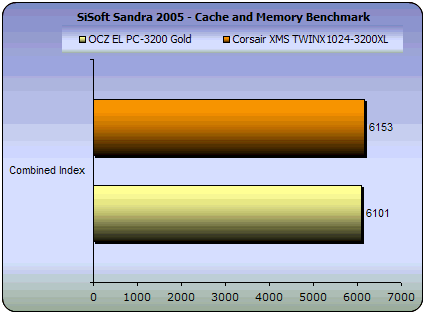
Speed Factor: is a figure representing the speed differential between the CPU’s cache and memory. The value is the ratio of the fastest cache (i.e. L1) bandwidth to the main memory bandwidth. (Lower is better, i.e. the memory is not very much slower than CPU’s cache)
As the factor is a ratio, it is useful only in comparing different CPUs and memory sub-systems rather than having a direct, physical interpretation associated to its numerical value.
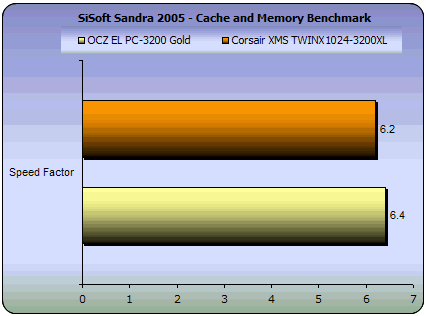
In all these tests, the Corsair memory was slightly faster than the OCZ memory. However, differences were not significant.

4. PCMark05
 PCMark05 is an application-based benchmark and a premium tool for measuring overall PC performance. It uses portions of real applications instead of including very large applications or using specifically created code. This allows PCMark05 to be a smaller installation as well as to report very accurate results. As far as possible, PCMark05 uses public domain applications whose source code can be freely examined by any user.
PCMark05 is an application-based benchmark and a premium tool for measuring overall PC performance. It uses portions of real applications instead of including very large applications or using specifically created code. This allows PCMark05 to be a smaller installation as well as to report very accurate results. As far as possible, PCMark05 uses public domain applications whose source code can be freely examined by any user.
PCMark05 includes 4 categorized suites for benchmarking your computer. These include CPU, Graphics, Memory and a Hard Disk Drive benchmark. In our case, we selected to run only the Memory test suite.
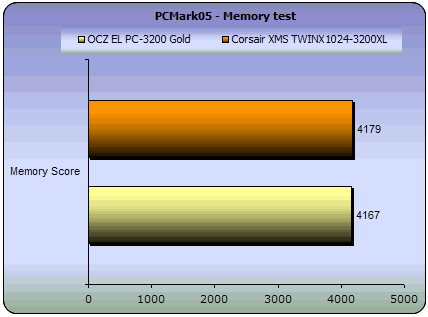
The PCMark memory tests reported that the Corsair XMS memory is slightly faster than the OCZ. So although once again the speed difference was not significant, it should be noted that in our tests, the OCZ memory modules produced exceptional performance and it is not easy to find memory modules that can compare with or even surpass this performance. But in this case, the Corsair modules have managed to do just that...
PCMark05
Memory Test |
OCZ EL PC-3200 Gold |
Corsair XMS TWINX1024-3200XL |
| Memory Read 16MB |
5980.346
|
6018.050 |
| Memory Read 8MB |
6147.309 |
6146.775 |
| Memory Read 192KB |
10619.192 |
10808.938 |
| Memory Read 4KB |
28020.150 |
28036.627 |
| Memory Write 16MB |
5909.063 |
5920.201 |
| Memory Write 8MB |
5903.680 |
5947.440 |
| Memory Write 192KB |
6985.763 |
7027.576 |
| Memory Write 4KB |
21447.723 |
21515.932 |
| Memory Copy 16MB |
5720.315 |
5745.178 |
| Memory Copy 8MB |
5809.182 |
5777.745 |
| Memory Copy 192KB |
3918.179 |
4420.483 |
| Memory Copy 4KB |
11354.204 |
11464.957 |
| Memory Latency 16MB |
12.941 |
12.462 |
| Memory Latency 8MB |
14.308 |
14.318 |
| Memory Latency 192KB |
134.870 |
134.880 |
| Memory Latency 4KB |
734.747 |
734.751 |
5. Performance Test v.5
 Passmark PerformanceTest is an award winning PC hardware benchmark utility that allows everybody to quickly assess the performance of their computer and compare it to a number of standard 'baseline' computer systems.
Passmark PerformanceTest is an award winning PC hardware benchmark utility that allows everybody to quickly assess the performance of their computer and compare it to a number of standard 'baseline' computer systems.
Twenty seven standard benchmark tests are available in seven test suites plus there are five advanced testing windows for custom benchmarking. CPU Tests, 2D Graphics Tests, 3D Graphics Tests, Disk Tests, Memory Tests and CD/DVD Tests. In our case we selected the Memory suite Tests.
- Memory Benchmarks
This suite contains a number of tests that exercise the memory sub-system of the computer. (Random Access Memory- RAM)
Memory - Allocate small block
This test measures the time taken to allocate & free small zeroed memory blocks (around 100KB block size)
Memory - Cached
This test measures the time taken to read a small block of memory. The block is small enough to be held entirely in cache (if one is present)
Memory - UnCached
This test measures the time taken to read a large block of memory. The block is too large to be held in cache.
Memory - Write
This test measures the time taken to write information into memory.

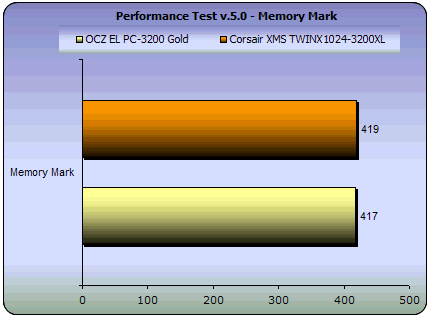
- Advanced Memory Benchmark
Memory Speed Per Access Step Size
The first test type, ‘Memory Speed Per Access Step Size’ accesses a large block, of memory in various sized steps. First, it runs through the block of memory sequentially, accessing every value. Next it runs through the same block again, except this time it accesses every second value. On this occasion, it runs through the block twice in order to access the same amount of data as the initial step. Next it runs through the same block again, except this time it accesses every fourth value and so makes four passes. And so on, until a certain maximum step size is reached.
The size of the block of memory used for this test is one quarter the amount of system RAM. The size of the steps varies from 1 (continuous sequential access), to one quarter the size of the block of memory ( i.e. one sixteenth of the system RAM ).
| Memory Speed (MB/Sec. per Step Size) |
| OCZ EL PC-3200 Gold |
| Block Read Speed |
20.31 |
| Block Write Speed |
23.47 |
| Corsair XMS TWINX1024-3200XL |
| Block Read Speed |
20.54 |
| Block Write Speed |
23.81 |
Memory Speed Per Block Size
When a computer program wants to use a section of memory to store data, it makes a request to Windows for the amount of memory it requires. Windows allocates the memory to the program ( unless system resources are very low ) and returns to the requesting program the address of the first memory slot in the allocated block. It is possible that some programs may request very large amounts of memory. The ‘Memory Speed Per Block Size’ test like the ‘Memory Speed Per Access Step Size’ test, is composed of many steps. During each step of the test, PerformanceTest requests a block of memory and runs through the block measuring the average access time. However on each subsequent step the size of the requested memory is increased, until finally a block close to the size of the system RAM is requested. In this way it is possible to observe the different access speeds for the different sizes of blocks.
Typically it is possible to see very fast memory access for blocks which are small enough to fit entirely into the L2 RAM cache, and slower access times for larger blocks accessed from main RAM. In the case where system resources are low, swapping to the disk may even be required for very large blocks.
| Memory Speed (MB/Sec. per Block Size) |
| OCZ EL PC-3200 Gold |
| Block Read Speed |
178.57 |
| Block Write Speed |
223.50 |
| Corsair XMS TWINX1024-3200XL |
| Block Read Speed |
179.43 |
| Block Write Speed |
223.90 |
The performance from both memory sets was excellent. Corsair XMS delivers exactly what it says, eXtreme Memory Speed.
6. Half Life 2 - Video Stress Test
 Half life 2 is no doubt the most anticipated PC game of all times.
Half life 2 is no doubt the most anticipated PC game of all times.
Physics - From pebbles to water to 2-ton trucks respond as expected, as they obey the laws of mass, friction, gravity, and buoyancy.
Graphics - Source's shader-based renderer, like the one used at Pixar to create movies such as Toy Story® and Monster's, Inc.®, creates the most beautiful and realistic environments ever seen in a video game.
AI - Neither friends nor enemies charge blindly into the fray. They can assess threats, navigate tricky terrain, and fashion weapons from whatever is at hand.

Very small FPS differences were reported with the Half Life 2 Video Stress Test. No matter which memory from the two you choose, the performance will be about the same.
7. Overclocking
Overclocking these of memory modules was easy, but unfortunately, not with the Abit motherboard we used for the previous performance tests. We had to switch to the ASUS A8N-SLI Premium motherboard, that uses the nForce4-SLI chipset. However, we did not use the motherboard in SLI mode, but instead the same hardware configuration as before, i.e. same VGA card, same CPU, same everything.

With the ASUS motherboard, Corsair managed to go as high as 312MHz, which is excellent. Although CAS Latency was reduced, 2.5-4-4-8 timings are very good, when running overclocked. The heat spreader proved itself very capable, keeping the temperature considerably low. The memory modules were warm to touch, but not hot enough so that you couldn't keep your finger on for a long time.

We re-ran some tests with the memory overclocked to see if there was any performance boost.






As you can see, the already good performer became even better. Especially with the Half Life 2 Video Stress, the fps boost was almost 15fps. Excellent performance...

8. Conclusion
Corsair XMS TwinX 1024-3200XL - Page 8
Conclusion
Corsair offers a very good package, with two XMS 512MB memory modules, already tested by Corsair to run in Dual Channel mode. The RAM modules are very eye catching concealed in their black heat spreader, giving the impression of high quality memory. Corsair has made an excellent choice in using Samsung chipsets that are known for their great performance and overclocking abilities.

In all our tests, the Corsair XMS memory modules managed to outperform OCZ's EL Platinum DDR memory. It is reminded that the OCZ memory modules were already one of the best performing memory modules available on the market and we were amazed to see the Corsair modules achieving such good performance.


The Corsair XMS memory showed great overclocking potential, managing to overclock at 312MHz without worries while MemTest reported no problem and even the temperature of the modules stayed comparatively low.


You can easily find Corsair memory on the market. The Corsair XMS TwinX1024 3200XL modules are priced at an average US$210.00. For their great performance, the Corsair XMS memory received CDRinfo's "Editor's Choice" award.

The Good:
- Excellent performance
- Great overclocking potential
- Stylish design with the black heat spreaders
The Bad:
- A lower price would be welcome